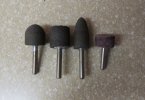- Joined
- Jun 11, 2006
- Messages
- 8,650
So I am looking for a way to reduce the time it takes to clean up the finger holes on my Q3 blades. Normaly when I’m making one at a time it’s not a big deal. I have a crap ton of 1/4” sanding drums and just use thoes. But thy are cheep and it takes a handfull of them per hole. But now that I’m doing these knives in a large (120+) batch I don’t have time to waste changing out these tiny drums.
In my searching I found a few options I thought I would consider. First was just getting an oscillating spindle sander and use a 3/4” drum. But to make use of that long of a drum the stroke would have to be quite large. My other option is a sleeveless sanding drum that you can use sand paper with. This sounded perfect at first as I could use high quality paper or possibly a ceramic belt that’s cut into squares. Then I did some more searching and found this. 3M makes a Cubitron ceramic drum sleeve. The one I would be after is the 3/4”x1.5” 240grit and thy are like $17 for 10. There rubber drum sander is good up to 10,000 rpm.
But I’m not sure which way to go. I don’t think the spindle sander is the way to go anymore. Im thinking a simple drum sander chucked up in a high speed air tool. Then each blade is clamped in the vise and I zip around the ID with the drum. I don’t know what the RPM limit is on the sleeveless drum sanders and I’m worried I would not be able to hit the needed rpm with that set up if I went with chopped up ceremic belts. Would be a lot cheaper then buying drums but time is also money. Thanks guys for any help you can provide.



In my searching I found a few options I thought I would consider. First was just getting an oscillating spindle sander and use a 3/4” drum. But to make use of that long of a drum the stroke would have to be quite large. My other option is a sleeveless sanding drum that you can use sand paper with. This sounded perfect at first as I could use high quality paper or possibly a ceramic belt that’s cut into squares. Then I did some more searching and found this. 3M makes a Cubitron ceramic drum sleeve. The one I would be after is the 3/4”x1.5” 240grit and thy are like $17 for 10. There rubber drum sander is good up to 10,000 rpm.
But I’m not sure which way to go. I don’t think the spindle sander is the way to go anymore. Im thinking a simple drum sander chucked up in a high speed air tool. Then each blade is clamped in the vise and I zip around the ID with the drum. I don’t know what the RPM limit is on the sleeveless drum sanders and I’m worried I would not be able to hit the needed rpm with that set up if I went with chopped up ceremic belts. Would be a lot cheaper then buying drums but time is also money. Thanks guys for any help you can provide.




